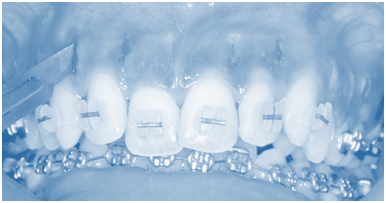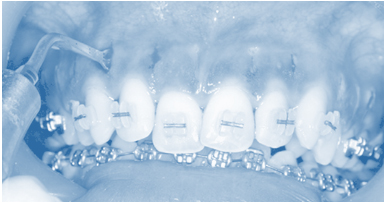What is Accelerated Orthodontics?
We live in a fast-paced world demanding faster and more predictable treatment outcomes.
Accelerated Orthodontics provides you with a beautiful and harmonic smile within half of the treatment time required for traditional braces and clear aligners. With Accelerated Orthodontics, aesthetically pleasing ceramic braces or clear aligners, e.g. Invisalign, can be worn in patients who prefer efficient results with non-metal braces.
The gradual and continual application of mild orthodontic forces initiates and maintains biological processes, resulting in a prolonged tooth movement type. Thus, the traditional orthodontics implemented for the past decades used to require a longer treatment time due to the limitations of bone remodelling activity or metabolic bone turnover.
Accelerated Orthodontics is a well-proven revolutionary adjunctive treatment approach that has been culminated by clinical research over the last two decades to prevail in clinical safety and predict faster orthodontic tooth movement by approximately two times.

Why Accelerated Orthodontics is needed?
- The digitally designed and fabricated series of clear aligners result in gradual tooth movement into the desired alignment.
- Dentists in London Specialists Dentists have experienced that most patients improve compliance to wearing aligners for 22 hours daily. However, the increased length of the treatment time is dictated by the increased complexity of each case, the number of aligners and the time interval between usually every 2 weeks.
- Clinical studies have proved that compromising any of these determinant parameters may adversely affect the planned magnitude of the teeth movement, leading to treatment failure due to poor-fitting aligners known as “non-tracking”.
In summary, any individual factors described below may be accountable for reducing orthodontic treatment success.
- Reduced aligners wearing time,
- Inherent anatomic and physiological dentoalveolar variations,
- Exceeded demand on individual tooth movement per aligner,
- Under-designed or suboptimal force vectors and anchorage system in each aligner,
- Individual physiological variations in bone turnover rate and magnitude
Therefore, to address each shortcoming factor, recent innovations in material science and aligner design technology have made progress in reducing untoward delays in the rate of tooth movement exerted by each aligner system.
According to the computer-generated Invisalign treatment plan, orthodontic tooth movement using clear aligners could sometimes take longer than planned.
The insufficiency of the planned tracking may increase with increased orthodontic complexity and discrepancy in tooth malposition.
What are the benefits of accelerated orthodontics?
The benefits are that the orthodontic treatment period is shorter, and oral diseases related to long-term braces, such as tooth decay or gum problems, are diminished. The orthodontic movement is performed faster and in a more biologically compatible pathway. Hence, with accelerated orthodontics, the patients observe the outcome and benefits of the treatment more quickly.
Additional benefits of Accelerated Orthodontics as a result of the biologically activated and augmented bone could be:
- An increased bone volume which can improve tooth support and facial aesthetics in some cases
- Increased post-orthodontic tooth stability
- Less demand for undertaking pre-orthodontic extractions
- Simultaneous reconstruction and restoration of the tooth-supporting bony and soft tissue defects
How would the total orthodontic treatment time be affected?
Accelerated Orthodontics enhances tooth movement into the desired position in about 2-4 times faster than expected using conventional treatment protocol.
The advantage of reducing the total treatment period increases patients’ orthodontic treatment acceptance and patient compliance hence case completion. The patients undertaking the fast-track accelerated orthodontic modality would complete their treatment more often than patients having conventional orthodontics.
Who can’t have an accelerated orthodontics treatment?
Patients with bone disease, ankylosed teeth, non-compliant patients, and heavy smokers.
What are the different methods of accelerated orthodontics?
There are a few different methods of accelerated orthodontics, with new methods being developed in recent times. Here are some of the most common methods:
-
Piezocision
Another method is Piezocision. It is a minimally invasive key-hole surgical procedure where a certain frequency of vibrations is used to cause micro-incision of the bone surface.
Any minimal discomfort felt by the patient usually lasts for around 12-24 hours following the procedure. -
Propel
Another option for accelerated orthodontics is Propel. Propel is a device which causes micro-perforations of bone surface. This stimulates the bone turn-over, hence accelerate the teeth movement. These perforations can be made at different stages during the orthodontic treatment.
-
AcceleDent
AcceleDent is a mouthpiece for home use. AcceleDent is a Class II on-prescription medical device approved by the FDA.
Soft-pulse technology generates micro-pulses upon biting the Accele-Dent mouthpiece, accelerating tooth movement.
High-frequency acceleration (HFA) using a vibration device affects the periodontal ligament (PDL) metabolism and physiological tooth movement, stimulating cytokines, bone remodelling, and tooth movement rate. -
OrthoPulse
OrthoPulse is a Class II on-prescription a mouthpiece medical device approved by the FDA.
OrthoPulse accelerates the tooth movement by using the phenomenon of photo-bio-modulation (PBM) via emission of low-intensity light (850 nm +/− 80 nm) to facilitate bone remodelling.
Is accelerated orthodontic a suitable treatment for all patient categories?
Accelerated orthodontics may not be appropriate or indicated in patients:
- who are non-compliant
- who are heavy smokers
- with active periodontal disease,
- with Inadequately performed endodontic treatment,
- with ankylosed teeth
- with a history of prolonged corticosteroid usage,
- on medication that interfere with bone metabolisms such as bisphosphonates or non-steroidal anti-inflammatory drugs.
- with bone disease
How long accelerated orthodontic procedure would take?
- Piezocision usually takes about 30 to 45 minutes
- Propelling usually takes about 30 to 45 minutes
- Acceledent is recommended to be used on a daily basis for 5 minutes
- OrthoPulse is used on a daily basis for 10 minutes during the entire duration of the orthodontic treatment.
What would be the postoperative pain or discomfort?
Some patients may experience some mild to moderate pain or discomfort during the first 24 hours after the procedure. Some patients may experience no pain or discomfort
If you have always been bothered by crooked teeth or have problems with biting and chewing but didn’t like the thought of wearing braces for many years, accelerated orthodontics may be a good alternative for you.
If you are interested in having an accelerated orthodontic treatment, make an appointment with a specialist here.


